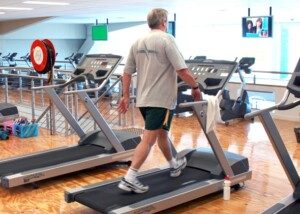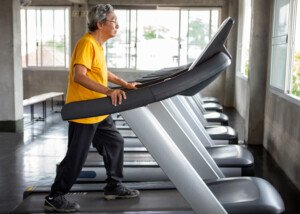Many people 65+ walk fast on a treadmill while tightly holding on, but a slower walk with your hands FREE is significantly better for the older body in many ways.
As usual, I saw an elderly woman on a treadmill at a fast pace – which may sound impressive because she was “old” and had the machine set to perhaps 3.5 mph, maybe 3.7.
But her hands were clamped on the side rails like vices, arms bent at a weird angle.
As a result, her entire body moved in an unnatural way.
• Her shoulder area and upper back were tensed up.
• Her hips were over-rotating to compensate for her upper body being locked up from the holding onto the rails.
• Her lower body moved in an unnatural way because her upper body was stiff from being locked up.
Many will argue that “at least she’s moving, which is better than sitting at home in a rocking chair.”
Stop that already. If you must compare the way someone exercises to rocking in a chair, then you just admitted that their way of exercising is so inefficient, that you must use an incredibly LOW standard for comparison!
Stop it. The only standard that makes sense is that of correct biomechanics when walking: good posture; natural hip movement; natural foot strike.
These features are suppressed when an elderly (or younger) woman or man grips a treadmill – whether it’s on the side rails, the bar in front or hands wrapped over the top of the console.
Yes, the rails are there. The manufacturer wants to appeal to as many consumers as possible.
The manufacturer also considers the one out of five million users who, if there were no rails, would fall and get injured – and then sue for half a million.
The rails and the bar in front should be used when absolutely necessary such as while changing the setting, drinking some water, checking heartrate, etc.
But the senior age woman I saw, plus so many other elderly treadmill users – along with many as young as in their 20s – was holding fast to the machine for the duration of the “walking.”
My critics will also point out that “she’s old, her bones are frail, she needs to hold on or she’ll fly off.”
Well YES, she needs to hold on if the tread is going at whippet speed!
It’s more efficient and beneficial for an old body to walk naturally, with a natural arm swing, without holding on – at a SLOW pace – than it is to grip those side rails or the front bar at a fast pace.
That older lady will have NOTHING to hold onto when she’s walking in a parking lot, around inside a store or other building, walking to her mailbox or walking Fluffie.
So just how is holding onto a treadmill going to make her more efficient at getting around during the activities of daily living?
There was no cane and no walker near this woman at the gym.
And that’s always the case: No cane or walker in sight.
- Treadmill grippers enter the gym without any assistance.
- If they’re with someone, they are not being supported by their companion.
- They are walking freely through the gym’s doors, walking unassisted to the locker room and unassisted again to the treadmill.
- But then they hold on. Makes no sense.
You may argue that they need to hold on because keeping up with a moving tread is an unnatural form of movement.
Though walking on a treadmill does not perfectly simulate walking around on a floor, a sidewalk or on grass, the moment you hold onto the treadmill you will knock the unnaturalness of it down several big notches.
Repetitive Stress Injuries from Holding onto a Treadmill
Old age means that the user is far more likely to acquire repetitive stress injuries from holding onto a treadmill.
The strain may occur in the over-rotating hips or the tensed-up shoulders or upper back. The altered foot strike may lead to foot pain.
But even if RSIs don’t result, there is something that will happen every single time when an elderly man or woman holds fast to a treadmill.
And that is the absence of improved ambulation. It’s the absence of all of the following: a stronger core, stronger legs, stronger knees, more stamina, more energy, better balance, lower blood pressure.
In fact, when one holds on tightly, this may raise blood pressure during the session higher than what it normally would be raised (exercise raises blood pressure during the activity).
One need not be a medical doctor or chiropractor to know that gripping a treadmill is bad for spinal alignment.
Just simply observe someone doing this. Their posture is often bad.
They may be hunched forward. Their arms may be bent funny. Their shoulders may be bobbing to-and-fro or up and down. Their entire gait is totally off. All of this is bad for an older body.
Walking on a treadmill without holding on, at a slower pace, is far more effective than is walking at a fast pace while holding on.
A person over 65 who’s new to treadmill use should start with a SLOW speed.
The machines go as slowly as half a mile per hour. That is very, very slow.
Instead, many elderly people set the speed to fast, even with first-time use, thinking that you have to go fast in order to make walking worthwhile.
But if you hold on, YOU ARE CHEATING and not truly walking.
Go slow without holding on. Let your body get used to keeping up on a slowly moving tread without holding onto the machine as a crutch.
Yes, hold on to momentarily steady yourself if you feel wobbly. But then release, as this will force your body to IMPROVE ITS BALANCE.
By letting go, the elderly body will be forced – and this is a good kind of “forced” – to get better with balance!
Holding on shuts down the body’s balance sensory system. It also skewers posture.
If while walking slowly without holding on, you don’t feel challenged, then there’s two things you can do.
- Gradually increase the speed, but not to the point where you’re fighting to keep balanced. Let your body gradually get used to slight increases in speed.
- Keep the speed slow but add a slight incline.
Many people go right ahead and crank the incline to very steep, then clutch the front bar or behind the top of the console, delusionally believing they’re mimicking walking a steep hill. NO, YOU’RE NOT.
If a person 65+ wants to improve their stamina, gait pattern, efficiency at walking, ability to get from point A to point B on uneven ground such as in a parking lot – they’re not going to accomplish any of these goals as long as they’re holding onto the treadmill.
 Lorra Garrick is a former personal trainer certified through the American Council on Exercise. At Bally Total Fitness she trained women and men of all ages for fat loss, muscle building, fitness and improved health.
Lorra Garrick is a former personal trainer certified through the American Council on Exercise. At Bally Total Fitness she trained women and men of all ages for fat loss, muscle building, fitness and improved health.
.


























